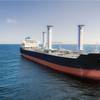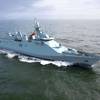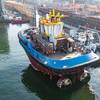Navy Explains FY-15 30-Year Shipbuilding Plan
The US Navy informs that it has delivered to Congress its annual long-range plan for the construction of naval combatant and support vessels for fiscal year 2015 (FY15) in summary as follows:
"Commonly referred to as the 30-year shipbuilding plan, we have highlighted a path forward that captures the required number of ships by type, as outlined in the FY12 Force Structure Assessment (FSA).
Our FSA identified those forces that most efficiently execute the missions and priorities of the Department of Defense (DoD) Defense Strategic Guidance (DSG) and meets requirements in the 2014 Quadrennial Defense Review.
This report builds and maintains a battle force inventory of near or above 300 ships, and ultimately shows that we can achieve the FSA objective of 306 battle force ships.
As we have done with previous submissions our plan assesses Department of the Navy (DoN) investments in battle force ships in three 10-year periods — near-, mid-, and far-term. The near-term 10-year period (FY15-FY24) comprises the FY15-FY19 Future Years Defense Program (FYDP) and the next FYDP. The mid-term planning period covers the two FYDPs between FY25-FY34, and the far-term planning period covers the two FYDPs between FY35-FY44.
Of note, this 30-year shipbuilding plan uses the new ship counting guidelines implemented in March to account for ship types routinely requested by the Combatant Commanders and allocated through the Global Force Management Allocation Plan (GFMAP). Regardless of whether we used the old counting methodology or our new ship counting procedures, we would still reach our 306 ship Navy objective.
During our PB15 budget submission we emphasized that we are operating in an environment of increasing fiscal austerity and uncertainty. Understanding these realities we applied a similar philosophy when drafting this year’s 30 year shipbuilding plan. This plan acknowledges fiscal unknowns/challenges moving forward — sequestration in FY16, Ohio Class submarine replacement procurement in the 2020s and ship recapitalization, however, the plan reflects FSA requirements. Our intent is to provide a sound plan that delivers capability to meet the DSG and QDR while sustaining the shipbuilding and combat systems industrial base as we build toward the future.
No doubt tough choices will have to be made to preserve our war fighting capability and force structure integrity. To put this into perspective, in order to reach the 306 ships outlined in the FSA then beginning in FY20 and running through the end of the 30-year shipbuilding plan, we require an average investment of about $17.2B (FY14 dollars) to finance, which is ~$4B a year more than our historical average annual investment of ~$13B a year. When you look at procuring the Ohio Replacement (FY25-FY34) the Navy will have to provide an average of $19.7B annually with the peak year in FY32 (~$24B).
As we have repeatedly emphasized, presence matters. The demand for naval forces worldwide remains high and we are uniquely positioned to be where it matters, when it matters. A successful shipbuilding plan remains a top priority for leadership and we understand budget uncertainty poses significant risks to the size of our fleet. We will continue to work with Congress to determine and build our Fleet without sacrificing capability.
Pictured: Chief of Naval Operations (CNO) Adm. Jonathan Greenert, center, speaks next to Secretary of the Navy (SECNAV) the Honorable Ray Mabus and Commandant of the Marine Corps Gen. James F. Amos before the House Armed Services Committee.
The 30-year shipbuilding plan is available at: http://1.usa.gov/1wojJXu














